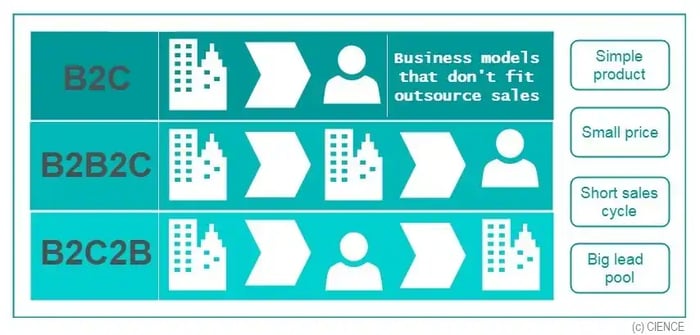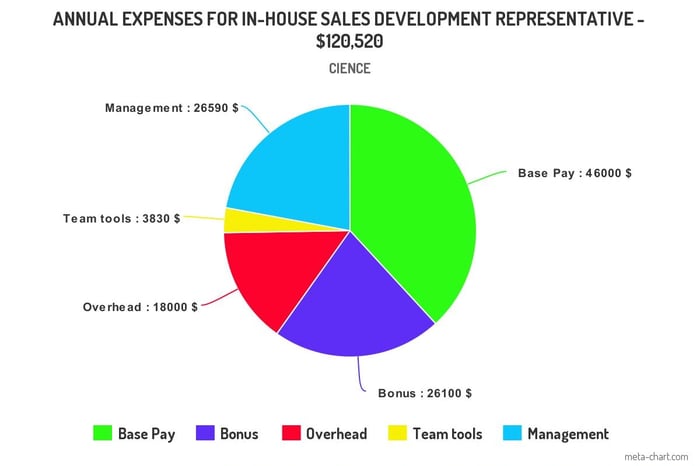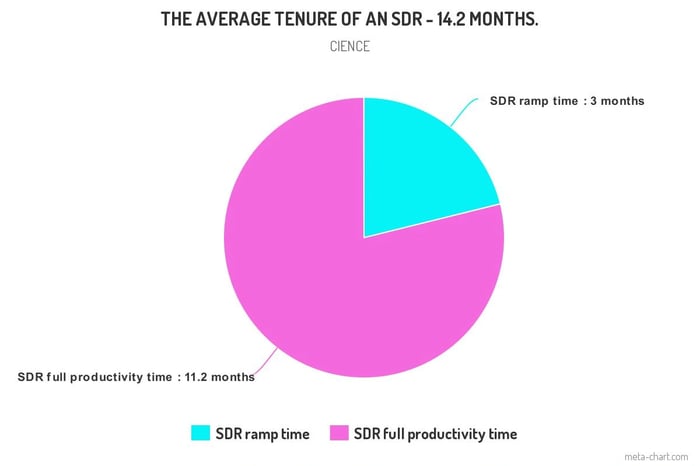1. Your Business Model Won’t Work
This is the major reason you shouldn’t outsource sales development. If you are B2C, B2B2C, or B2C2B, it’s highly likely your business model simply won’t fit an outbound model. Much of this comes down to your product pricing. It’s unlikely an Average Contract Value lower than $1,000 will be able to sustain both outsourcing sales development reps (SDRs) and the account executives that then work new opportunities developed.
Other hallmarks of bad fits are short sales cycles or largely horizontal pools of leads. Essentially, where Personas are less important than simply reaching masses of people, as outbound prospecting isn’t the most efficient method to attract broad swaths of new clients. In these cases, businesses are wise to invest more in marketing, advertising, and freemium product strategies.

Grammarly is a good example of successful B2C2B. Initially, it had only paid accounts. According to Alex Shevchenko, the program's developer, the company was losing 95% of potential users due to this approach.
After a mammoth $110 million funding round in 2017, Grammarly today boasts both freemium and premium services. Over 95% are freemium users, amounting to over 10 million people around the globe.
They create word of mouth and tons of potential customers. Professional content writers and journalists will always seek to have Premium and will persuade their employers to purchase it. With such a model, Grammarly simply doesn't need the outbound prospecting. They have automatized their sale process.
2. You think sales outsourcing is too expensive
In fact, it's the most popular argument our own SDRs hear over the phone. Fees for outsource firms range in the thousands of dollars per month.
Companies that have never used these kinds of services believe it will cost them a fortune, and that an in-house team will be less expensive with greater control.
Challenging this assumption
The reality is quite the opposite. According to most surveys, cost savings is the primary reason for outsourcing. Interesting data from leading job sites like Glassdoor, Indeed, and AngelList suggest the average SDR base salary ranges from $47.8 to $62K.
This is in line with survey data from the The Bridge Group’s Sales Development Metrics and Compensation Research Report which also reports On-Target Earnings (OTE) inclusive of commissions/bonuses of $72.1K.
None of these costs usually factor in software, hardware, or other typical overhead -- often 25% of salary. And the least factored part of in-sourcing is the allocation of management time, money, and resources. Figures, all-inclusive of these hidden costs, can easily run into the six figures.

It gets worse. In 2018, the SDR position largely serves as a short-term launchpad of a sales career (or brief foray into the land of rejection in a job many cannot handle).
The average hire comes with less than 12 months experience and an average tenure of under 15 months (including ramp time). It’s rare to find organizations allocating human resources costs for the endless treadmill of hire, train, and retain required for insourcing.
In other words, companies spend 26% of their time on training, which takes a manager’s time and efforts resulting in positive productivity for less than a year.

Here's one more thing to analyze, when you consider sales outsourcing. Along with cutting costs, companies usually try to estimate qualitative ROI using the following criteria:
- Freeing the time of your in-house employees (usually sales account execs)
- Improvement of analysis and planning (consistent opportunity creation)
- Acquisition of knowledge and experience
- Strategic value (building pipeline)
- Innovation
Basically, employees with less than a year of experience shouldn’t be expected to bring innovation and strategy to your company. Their first year on the job focuses on learning.
Insourcing comes with a multitude of costs, most of them hidden. Outsourcing, on the other hand might appear expensive, but costs will always be obvious. Be sure to run a thorough either/or analysis before drawing conclusions on which is truly most expensive.
3. You think cold calling is dead
There are a multitude of voices arguing cold calling and emailing are dead. Without a doubt, there are more headwinds facing direct targeting of leads than ever before. Especially as pointed out by those promoting social selling or similar agendas.
Part of this line of thought is rooted in the belief cold outreach is an unpleasant, unsavory, and unproductive use of time.
Challenging This Assumption
The cold reality of cold outreach is it’s the only way to guarantee direct targeting must-win logos that matter to your business. It’s one of the reasons Account Based Marketing and Account Based Sales are such trending topics over the last few years:
Account Based Marketing and Sales are a broad market response towards the ever-greater and more sophisticated use of outbound tactics.
Each of the 20 fastest growing B2B SaaS companies have implemented outbound outreach. Each B2B company to issue an IPO in 2017 has embraced outbound. This is a successful, productive go-to-market strategy practiced by the fastest-growing companies in the world.
Further, according to a recent study on the most popular sales myths by the RAIN Group, the earlier your outreach occurs in the purchase process, the better. And by earlier, this often means before buyers even understand what they really need.
4. You think you won't have control over an outsourced sales development team
Understandably, when it comes to sales, control is a top reason for not outsourcing. SDRs are people who contact your potential clients directly. You don't want them to screw it up.
Furthermore, you want to be sure that they don't waste their time and avoid cold calling -- the dreaded Call Reluctance Syndrome -- as some might make the case this is the most unpleasant part of any SDR's job.
Challenging This Assumption
Having a sales rep who’s constantly out of sight looks like a total loss of control. This is partially true. But only if you think of control as 100% supervision over every action your staff makes with your oversight, which isn't an effective option in a distributed world.
We believe an effective SDR should be a self-manageable entity, capable of doing at least 90% of the work on their own (if not more). As it stands, the work itself is pretty much a solo endeavor.
There’s an argument to be made that teamwork matters too. And doing rejection-filled work all-day, everyday, requires the moral support only peers can give. As such, in our own organization, our SDRs work side-by-side and provide the type of esprit de corps that simply isn’t possible in small or heavily matrixed organizations.
Having a dedicated team, such as pairing SDR’s with Sales Researchers, working across blocks of other SDR teams, plus Customer Success, QA, and management oversight are nice checks and balances to any fears of control loss.
Not to be overlooked are shared goals. Any outsourced sales agency worth its salt only succeeds when clients succeed.
As such, monitoring of minutes, activities performed, and advanced analytic charting of progress should always be part of the equation. We know properly organized communication and reporting are the best way to supervise and manage sales reps:
-2.jpeg)
Setting points and criteria for control of SDRs in an outsourced model will often deliver ">greater visibility than even in-house methods.
And absolutely guarantee something insourcing will not -- enabling your sales team to spend more time on more valuable tasks than research and prospecting, such as analysis, planning, account management, and closing deals.
5. You don't want feedback from your market / You don't know how your product stands out
Surprisingly, we’ve met many such companies. They didn't understand the value of their product and how they are different from the competition -- and they often didn’t care to learn why. In a purely inbound model, these blind spots aren’t always glaringly obvious. Marketers rarely have to deal with objections.
And that's the reason why such businesses absolutely don't match a sales outsourcing model.
The value of your product/service becomes a focal point of conversations SDR’s start with prospects. This requires researching a lead’s business first to see how an offer can fit and help.
Good SDR’s will always do their homework first, to understand why any prospect will even care. Then they’ll keep the conversation going by bringing relevance to bear to any appointments they set.
Market learnings are some of the most valuable things a sales outsourcing team can bring you. Hence every response is reported, and you’ll get to know what your potential buyers actually think about your product, your competitors, and their own needs -- some of which you may not like or want to hear.
Think of the beneficial perspective on how your business and your product looks from a potential customer's point of view -- but only if you’re prepared for the unvarnished truth.
Summary
It’s easy to take a casual view of sales development outsourcing as something that doesn’t fit your company. It’s rather effortless to dismiss the merits of an outsourced approach without digging in -- after all, the status quo is a powerful force.
However, challenging assumptions on reasons not to outsource sales development may make you think differently about your business and, perhaps, even make you a candidate to grow through outsourcing.
Should you decide to Outsource, here’s a primer on must-ask questions for vendor selection: Lead Gen Managed Services - Buying Guide.
Sales Organization Structure


